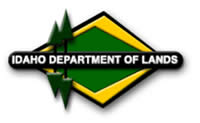
National Fire Plan Success Story
Idaho Panhandle National Forests and Idaho Department of Lands
Success in Interagency Cooperation
National Fire Plan - Firefighting
2008

FIRESTORM 91, as it was dubbed by the press, occurred October 16, 1991, as a severe cold front moved through Washington and North Idaho with winds measured up to 62 miles per hour. Mostly downed power lines ignited a number of fires. Fuels tinder dry from 47 days without rain started easily and moved rapidly through timber stands and the wildland urban interface. By the evening of October 16, North Idaho had 11 major fires going, 11 buildings were destroyed, and one volunteer firefighter had lost his life in the suppression effort.
Northern Idaho is about 20 percent farmland and 80 percent forested. The Idaho Panhandle National Forests (IPNF) administers approximately half of the total forested acres. Small woodland owners own one-fourth of the forested land; the remainder is owned by industries or other government entities, mainly the Idaho Department of Lands (IDL). IDL is tasked by Idaho State code to provide protection for State and private forested lands. Together the IPNF and the IDL provide wildland fire protection for over 5,700,000 acres. Firestorm 91 was the catalyst that demonstrated to wildland fire agencies in North Idaho as well as city and rural fire departments that all agencies needed to step up the level of interagency cooperation to deal with the ever expanding wildland urban interface and risk of wildland fires.
The following summer the IPNF, IDL and Fire Departments in Kootenai County developed and supported a standing Type 3 IMT in the County. The first incident that the T3 IMT was utilized for was an all hazard incident, a train derailment outside the community of Rathdrum. The participation of the local T3 team was a resounding successful as the team managed the incident in a professional manner and demonstrated the benefit of cooperation to all agencies involved with the incident as well as the benefit of interagency participation in local incident management teams. The team has since managed emerging wildland fires, larger fires when Type 1 or 2 teams were not available, long duration wildland fires and additional all hazard incidents such as floods.
The success of the Kootenai County Interagency Type 3 IMT served as a foundation to build stronger relationships and higher levels of cooperation. In 1998, the wildland fire agencies opened the Coeur d’Alene Interagency Dispatch Center (CDC). CDC provides both Initial Attack dispatching as well as coordination center dispatching for out of zone assignments. The agreement to cooperate with the dispatch center has evolved to now include the Coeur d’Alene Cache. Member agencies share in staffing and operations of the two facilities.
The protection area covered by CDC is broken into three zones, North, Central and South.
Two additional T3 IMTs were staffed in 1998, one on the North Zone and one on the South Zone. The Kootenai County T3 IMT was changed to the Central Zone team. In 2007 and 2008 the teams have been assigned to incidents on adjacent units.
Benefits:
- Local fire managers thought that T3 IMTs would be a good training platform to move firefighters from T3 to T1 and 2 teams. While this has happened to a small degree the majority of the team members are employees that want to be involved with fire but can’t commit to the frequency of availability and travel that T1 and 2 teams require thus increasing the level of participation in Incident Management Teams.
- Increased participation with local fire departments
- Increased flexibility in managing emerging incidents and lightning busts with standing organizations that can mobilize in 2 hours or less.
- Ability to manage larger fires with an organized team when T2 teams are not available.
Contact: Mark Grant, Fire Management Officer, (208) 765-7499.